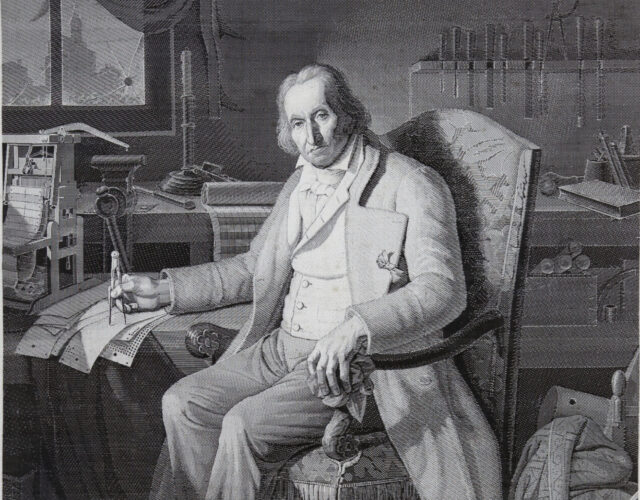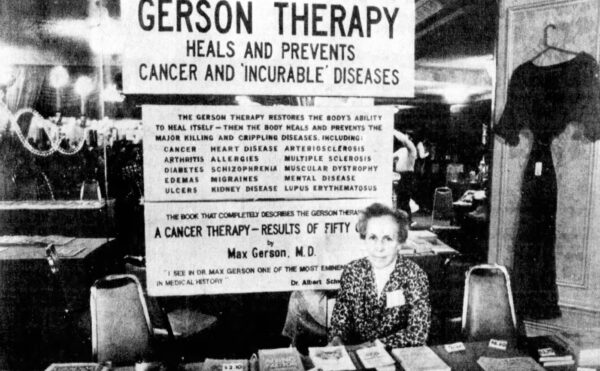In December 1839 mathematician and economist Charles Babbage sent a letter to French astronomer François Arago. “There has arrived lately in London . . . a work which does the highest credit to the arts of your country,” he wrote. The item that had captured Babbage’s attention was a portrait of French inventor Joseph-Marie Jacquard. Babbage wanted a copy to show off in his London home, where he often entertained members of the British elite. Three years later he welcomed a pair of very special guests, the Duke of Wellington and Queen Victoria’s husband, Prince Albert. He later recalled the moment in his autobiography:
The prince had seen another copy of Jacquard’s portrait, based on a painting by Claude Bonnefond, and knew its secret. As Babbage explained later, it was a “sheet of woven silk, framed and glazed, but looking so perfectly like an engraving, that it had been mistaken for such by two members of the Royal Academy.”
For Babbage the portrait was much more than a fine example of textile arts: what fascinated him was the mechanism through which it was created. The silken image and the machine that made it (seen on the desk next to Jacquard in the portrait) represented the technological potential of the calculating machines that had occupied Babbage’s attention for the past two decades.
For centuries weavers had relied on a machine called a drawloom, which drew up the lengthwise (warp) threads individually, allowing different-colored cross (weft) threads to be inserted underneath. By selecting which threads to raise and lower during each pass of the shuttle, weavers created patterns or images in their tapestries, but the task was cumbersome. Each row of weaving might contain hundreds of warp threads—so many that a second person (a “drawboy”) was typically enlisted to keep track of which ones to raise or lower.
Over the years many people had tried to speed up the weaving process. In 1745 a talented machinist, Jacques de Vaucanson, designed a loom that used a spoked metal cylinder—similar to those found in music boxes—to trigger hooks that would raise or lower particular threads. Vaucanson’s prototypes worked well, but the cylinders were expensive and could only generate a single, repeated pattern.
The silken image and the machine that made it (seen on the desk next to Jacquard in the portrait) represented the technological potential of the calculating machines that had occupied Babbage’s attention for the past two decades.
Jacquard, who had worked as a drawboy in his youth, inherited his father’s weaving business in Lyon but found it difficult to make a profit. After squandering most of his inheritance he later took up arms to support the French Revolution, returning home in 1798 after the death of his son. By the turn of the century he was working on an invention that had both local and national implications. Success would bolster silk production in Lyon and support Napoleon’s efforts to match the industrial output of Great Britain.
Jacquard replaced Vaucanson’s drums with punched paper cards. Each card passed before an array of circular metal rods corresponding to different warp threads. Whenever a rod came into contact with solid cardboard, its associated warp thread stayed in place. If it passed through a hole, then a mechanism lifted the thread. By punching multiple holes in a card any combination of threads could be raised long enough for a weaver to slide the shuttle across. Linking cards together with string allowed weavers to repeat this process for each row, eliminating the need for a drawboy.
Jacquard took his invention public in 1802. Since his new loom could be overseen by a single person, decorated fabrics could be produced more than 20 times faster than with traditional looms. Unlike drum-based systems, which were best suited for repeating patterns, there were no limits to the possible outputs of a Jacquard loom—the greater the number of cards, the greater the sophistication of the design. Didier Petit and Company used approximately 24,000 cards to produce the Jacquard portrait that had caught Babbage’s eye.
Babbage realized that this new loom, or at least the cards that guided it, might enable the creation of a new form of calculating machine. Since the 1820s he had been pondering the use of such devices to produce improved mathematical tables. Astronomers, surveyors, and navigators had relied on such tables to carry out the complex calculations associated with their work. Compiling these tables was a repetitive, tedious task but one that had to be performed with utmost care. Errors in navigational tables, for example, could send sailors miles off course or lead to a shipwreck. Babbage had assisted in the making of these tables as a member of the Royal Astronomical Society, and he became convinced that a machine would be better suited for the job. After a year of lobbying, in 1823 the British government offered Babbage financial support to build a clockwork device he called the difference engine, which used the differences between terms in a mathematical series to generate a navigational table’s contents.
Since Jacquard’s new loom could be overseen by a single person, decorated fabrics could be produced more than 20 times faster than with traditional looms.
Ultimately Babbage never completed his difference engine. After building a section of it as a demonstration piece in 1832, which he occasionally showed off to guests at his London dinner parties, he set it aside to pursue a more ambitious project directly inspired by Jacquard’s handiwork. By that time the Frenchman’s loom had crossed the Channel and found a home in English textile factories. Babbage was deeply familiar with advances in industrial machinery and recognized that Jacquard’s punch cards offered the prospect of “a totally new engine possessing much more extensive powers.” Unlike the difference engine, which could only produce mathematical tables, this new “analytical engine” would be able to perform any calculation.
The analytical engine’s greater flexibility came at the cost of a more complex design. Babbage once again lobbied British officials to pay for its construction, but his failure to complete the difference engine made it difficult to justify supporting an even more expensive project. In the absence of government subsidies Babbage spent years sketching blueprints for the analytical engine and persuading others of his idea’s long-term potential. He received assistance in the latter task from Ada Lovelace, the daughter of poet Lord Byron and Babbage’s most eloquent advocate. Lovelace recognized that what distinguished the analytical engine from other calculating machines was the use of punch cards to supply numeric inputs and instructions—what we might refer to today as “programming.” As she wrote, “We may say most aptly that the Analytical Engine weaves algebraical patterns just as the Jacquard-loom weaves flowers and leaves.”
Although Babbage never completed any of his engines, his vision of programmable calculating machines with operating instructions encoded on punch cards proved remarkably persistent. In 1889 an American engineer named Herman Hollerith built a tabulating machine along similar lines for the U.S. Census Bureau. Hollerith founded a company to commercialize his inventions, which after several mergers was renamed International Business Machines (IBM). IBM punch-card readers would later be used in ENIAC, the first electronic computer, and many of its descendants. The Jacquard portrait, recently added to CHF’s collections, is an elegant embodiment of that data-driven future.




